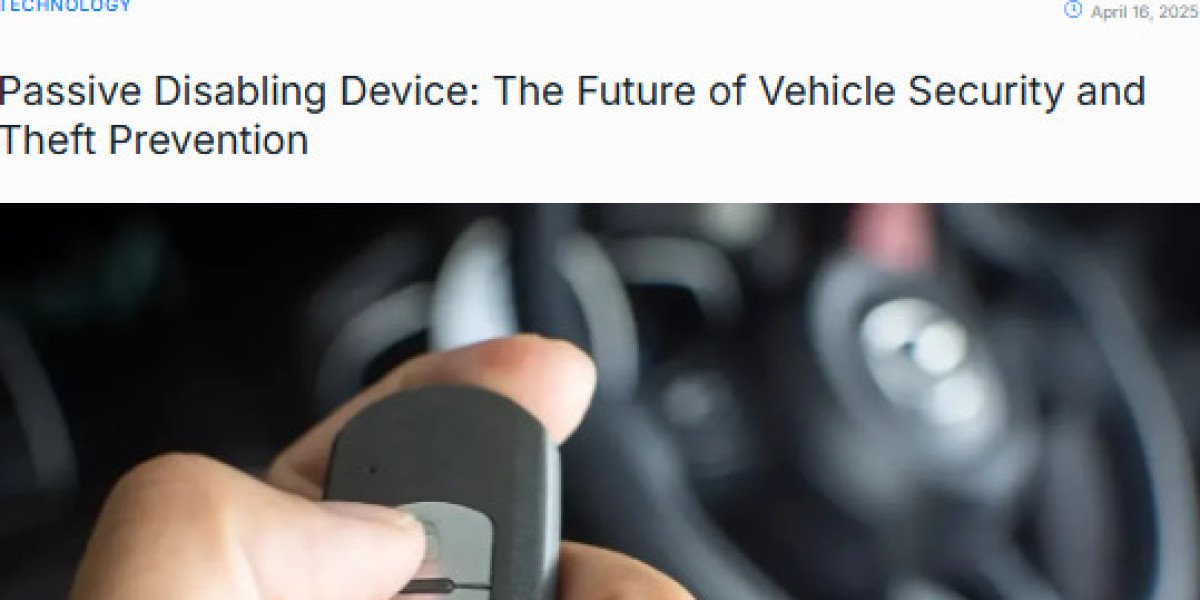In a rapidly evolving world where security threats are ever-present, technological advancements have led to the creation of sophisticated systems designed to safeguard people and property. Among these innovations, the Passive Disabling Device (PDD) stands out as a unique and pivotal solution. Unlike traditional security measures that actively detect and respond to threats, passive disabling devices work in a more subtle, yet incredibly effective way. This article explores the concept of Passive Disabling Device, their mechanisms, applications, and how they are transforming security strategies across various industries.
What is a Passive Disabling Device?
A Passive Disabling Device (PDD) is a security technology designed to neutralize or disable a threat without direct interaction or active intervention from the user. These devices work quietly in the background, often without the need for human input, and are typically implemented to prevent or reduce the impact of unauthorized access, theft, or other malicious activities.
Unlike active disabling devices, which require external inputs like remote signals, sensors, or manual intervention to trigger a disabling action, passive devices operate autonomously based on pre-programmed parameters. This makes them especially useful in high-risk environments where a rapid response is needed, and the margin for error is minimal.
How Do Passive Disabling Devices Work?
At their core, Passive Disabling Devices rely on a combination of sensors, mechanisms, and pre-configured logic to detect specific conditions or breaches in security and disable the target in some way. The "passive" nature of these devices means that they do not require human activation to perform their functions. Instead, they work automatically once the conditions for activation are met.
For example, in the automotive industry, a passive disabling device may be integrated into a vehicle's ignition system. If the system detects an unauthorized attempt to start the vehicle, the device will disable the ignition system without requiring the driver to take any action. The vehicle remains immobilized until the authorized user inputs the correct credentials.
The key feature of passive devices is that they are built to function quietly and without alerting the intruder or target. This subtlety is crucial in preventing the attacker from bypassing the system before it takes effect.
Types of Passive Disabling Devices
1. Vehicle Immobilization Devices
In the realm of automotive security, Passive Disabling Devices are widely used to prevent theft. These devices are designed to disable critical systems within the vehicle—such as the ignition or fuel system—once a security breach is detected. Modern vehicles often feature electronic immobilizers that prevent the engine from starting if the correct electronic key or transponder is not detected.
This technology has proven effective in reducing car thefts. The passive nature of these systems ensures that even if a thief bypasses other security features, they will be unable to start the vehicle unless they have the proper credentials.
2. Smart Locks and Electronic Access Control
Passive Disabling Devices are also common in buildings and secure facilities, where they are integrated into smart locks and electronic access control systems. These systems can disable access to specific areas when certain conditions are met—such as an unauthorized entry attempt or a failed authentication process.
In such applications, passive devices may lock down doors or restrict access without requiring any active intervention from security personnel. The system may automatically detect a breach, lock the doors, and notify authorities, all without the need for manual input.
3. Biometric Security Systems
Biometric security systems, often used in high-security environments like government buildings or corporate offices, are another area where passive disabling devices come into play. These systems use fingerprints, iris scans, or facial recognition to verify the identity of users.
If the system detects a mismatch or an unauthorized attempt, it may trigger a passive disabling device that locks out the intruder or disables further access attempts. By doing so, it ensures that only authorized personnel can enter sensitive areas.
4. Retail Anti-Theft Systems
Retail stores have long relied on passive disabling devices to prevent shoplifting. These systems use security tags or RFID tags attached to merchandise. If a customer attempts to leave the store without properly deactivating or removing the tag, the passive device activates an alarm or disables the tag’s functionality.
These systems require no interaction from store employees and can function quietly, preventing theft without alerting the potential thief to the security system's actions. This non-intrusive approach is particularly effective in minimizing theft while avoiding confrontations.
5. Smart Home Automation
In the growing field of home automation, passive disabling devices play a significant role in protecting residential properties. For example, smart security systems in homes often use passive devices to automatically lock doors, turn on lights, or activate security cameras when an intrusion is detected.
In these systems, the passive nature of the devices ensures that homeowners do not need to manually intervene during a potential security breach. Instead, the system autonomously detects irregular activity and responds by neutralizing the threat—whether that’s through locking doors, alerting emergency services, or triggering alarms.
Benefits of Passive Disabling Devices
1. Increased Security
By silently disabling or neutralizing a threat without human intervention, passive devices add an extra layer of security to any environment. Since they operate autonomously and in the background, attackers have a limited window of opportunity to counteract the device's effects. This reduces the chances of a successful breach.
2. Reduced Risk of Human Error
One of the biggest advantages of passive disabling devices is their ability to operate without relying on human input. This greatly reduces the risk of human error, such as forgetting to activate a security feature or incorrectly configuring a system. The device works automatically, ensuring that security is maintained at all times.
3. Enhanced Discreetness
Passive Disabling Devices operate in a quiet, often unnoticed manner. This means that they can incapacitate a threat without alerting the intruder to their presence. In situations where stealth is critical, such as in high-value asset protection or personal security, this feature is invaluable.
4. Cost-Effectiveness
Because passive devices typically require less maintenance and oversight than active systems, they can be a more cost-effective solution over time. Once installed, they can operate autonomously, reducing the need for constant monitoring or manual intervention.
Challenges and Limitations
Despite their benefits, Passive Disabling Devices are not without their challenges. One of the main concerns is the potential for false activation, which can result in inconvenience or even damage. For instance, in the case of automotive immobilization devices, a malfunction could lead to the vehicle being disabled when no threat is present.
Additionally, while passive devices are effective at preventing unauthorized access, they are not always foolproof. Skilled attackers may still find ways to bypass or disable the device, especially if it’s not regularly updated or properly maintained.
The Future of Passive Disabling Devices
As security needs continue to evolve, so too will the technology behind Passive Disabling Devices. Future innovations may involve more advanced sensing technologies, machine learning algorithms, and integration with other security systems to create even more effective solutions. With growing concerns around cyber threats, it's also likely that passive devices will evolve to offer protection against both physical and digital vulnerabilities.
In conclusion, Passive Disabling Devices offer a unique and vital solution in the ever-growing landscape of security technology. Their ability to work silently and autonomously, combined with their potential to reduce human error and enhance overall security, positions them as a crucial element in the fight against theft, unauthorized access, and other malicious activities. As technology advances, it’s clear that passive security solutions will continue to play a pivotal role in creating safer environments for all.






